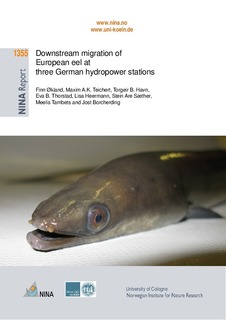| dc.description.abstract | Økland, F., Teichert, M.A.K., Havn, T.B., Thorstad, E.B., Heermann, L., Sæther, S.A., Tambets, M. & Borcherding, J. 2017. Downstream migration of European eel at three German hydropower stations. NINA Report 1355: 53 pages, including appendix.
Background and methods
The aim of this study was to examine migration behaviour and losses of European silver eel when passing three run-of-the river hydropower stations in Germany. These were the Unkelmühle power station in the Sieg, the power station in Gengenbach in the Kinzig (both tributaries to the Rhine), and Kuhlemühle power station in the Diemel (tributary to the Weser).
The Unkelmühle power station is designed with several bypass routes where fish can pass outside the turbines. At the power station in Gengenbach, the position of a movable turbine can be adjusted to let downstream migrating fish pass above or under the turbine. Narrowly spaced bar racks have been installed in front of the turbine intakes at both Unkelmühle, River Sieg (10 mm), and Gengenbach, River Kinzig (15 mm), to prevent fish from entering the turbines. At the Kuhlemühle power station, River Diemel, an Archimedes screw turbine is installed without a bar rack in front of its entrance. Archimedes screws are regarded as being fish-friendly turbines, but few studies have tested this assumption.
The study was performed during 2014 to 2016 by tagging 542 European silver eels with radio transmitters. Their migration in the river and past the power stations was recorded.
Results and conclusions
Overall, we recorded low mortality for downstream migrating silver eels at these power stations. However, there are uncertainties linked to the survival estimates, particularly at Gengenbach and Kuhlemühle.
The mortality of eels when they passed the Unkelmühle power station was 0-4% and 0-8% in the two consecutive study years. This shows that it is possible to obtain low mortalities for downstream migrating eels at run-of-the-river power stations with special protection measures to facilitate migration and reduce mortality. No direct turbine mortality occurred, as no eel slipped through the bar racks in front of the turbines, as expected due to the narrow bar spacing.
The reason that we give mortality estimates as a range (0-4% and 0-8%), is that the fate of some tagged eels after passing the Unkelmühle power station is unknown, which makes it difficult to determine if they were alive or dead after passing. Further, three individuals showed movements indicating that they were taken by birds, but it is not known whether they were dead at the power station and taken by bird predators, injured by passing the power station and therefore taken by predators, or whether they were uninjured but taken by predators anyway. The estimates given as ranges take this uncertainty into account, and imply that the mortality at the Unkelmühle power station could have been zero in both study years, but the mortality could also have been up to 4% in the first study year and up to 8% in the second year.
If there was some mortality linked to passing Unkelmühle power station, this must have been due to injuries occurring in the bypass routes, or increased predation at the power station area. Increased predation may occur if fish are injured and thereby easier prey. It is also possible that presence of injured fish of different species at power stations attracts predators, such that the likelihood of being taken by a predator increases also for uninjured fish.
None of the tagged eels became stationary at the power station, indicative of being dead, neither at Gengenbach or Kuhlemühle. However, there are uncertainties for the survival estimates at these power stations, because eels may drift downstream after they are dead. Release of tagged dead eels showed that eels that potentially died when passing Gengenbach or Kuhlemühle could have drifted several kilometers and out of the monitored area below the power stations. Hence, mortality at the power station is in such cases not necessarily detected. The survival estimates at Unkelmühle were more certain, because the fish were tracked over a longer distance below the power station, and implicitly there were fewer individuals with an uncertain fate. Some eels became stationary on river stretches below Gengenbach and Kuhlemühle power stations, and might be dead (14% and 23% of the eels that passed the Gengenbach and Kuhlemühle, respectively). However, eels may cease migration and migrate downstream another year, so an eel becoming stationary may not necessarily be dead.
Eels mainly used migration routes with a large proportion of the water flow when passing the power stations. At Unkelmühle, most of the downstream migrating eels used the spillway gate, or the bypass route leading fish from the bar racks in front of the turbines into the flushing channel and back to the river via a route outside the turbines. Only two eels used the custom-made side bypasses for eels, and only a small proportion of the eels (<10%) used the custom-made bottom bypass at Unkelmühle.
At Gengenbach, the largest proportion of eels passed through the section where the moveable turbine was installed, and at Kuhlemühle, the largest proportion passed through the Archimedes screw turbine. A potential negative effect by Archimedes screw turbines may be migration delays. However, most eels migrated fast through the Archimedes screw turbine, and did not hesitate or stop the migration either upstream or downstream of the turbine. In fact, eels migrating through the Archimedes screw turbine or over the dam passed the power station area faster than eels using the other routes. Hence, eels were not markedly delayed in their downstream migration by using the Archimedes screw. However, there was large individual variation, and some individuals spent a long time in passing the power station. | nb_NO |
